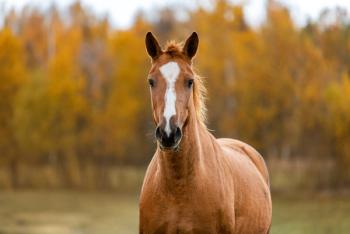
Foal disorder linked to autism in people; new veterinary treatment may hold clues
Dr. John Madigan believes pressure in birth canal cues change in neurosteroids.
Courtesy of Joe Proudman, UC DavisVeterinary researchers at the University of California, Davis, are exploring possible ties between a foal disorder and autism.
Abnormal levels of naturally occurring neurosteroids may be the common link, according to a UC Davis release. The horse disorder-known as neonatal maladjustment syndrome-has been a mystery for a century. Signs of the little-understood condition that appear in 3 to 5 percent of live births are detachment, failure to recognize their mothers and no interest in nursing.
“The behavioral abnormalities in these foals seem to resemble some of the symptoms in children with autism,” says John Madigan, DVM, MS, UC Davis veterinary professor and expert in equine neonatal health, in the release.
Nursing newborn horses with the disorder is demanding. Eighty percent of foals survive with intensive care in a veterinary clinic and constant bottle or tube feeding for up to 10 days.
Hypoxia-insufficient oxygen during the birthing process-has been cited as the cause of the disorder. However, Madigan and UC Davis colleague Monica Aleman, MVZ, PhD, DACVIM (internal medicine, neurology), point out that hypoxia has permanent consequences while most foals with maladjustment syndrome don't present long-term problems.
Impact of neurosteroids
Researchers are eying naturally occurring neurosteroids as a top suspect in causing the disorder. The compound acts as a sedative and keeps the foal “quiet” before birth.
“Foals don't gallop in utero,” Madigan says in the release. However, the foal must be able to run shortly after its birth. The biochemical change the newborn undergoes in the birth canal may be triggered by the physical pressure of the birthing process, researchers believe.
“We believe that the pressure of the birth canal during the second stage of labor, which is supposed to last 20 to 40 minutes, is an important signal that tells the foal to quit producing the sedative neurosteroids and ‘wake up,'” Madigan says in the release.
The theory is backed by data. Horses that were delivered via cesarean section or experienced unusually rapid births presented clinical signs of neonatal maladjustment syndrome more frequently. These foals may not experience enough pressure to cue the change in neurosteroids, Madigan says.
Researchers have also found thatnewborns have sedative neurosteroids in their bloodstream, and levels are elevated in those with the syndrome. The compounds can cross the blood-brain barrier, affect the central nervous system and act on the same receptor, as do sedatives and anesthetics.
Using several loops of a soft rope to gently squeeze the foal's upper torso for 20 minutes-to mimic the time spent experiencing birth canal's pressure-can ease the disorder's symptoms, researchers have found. Early cases have produced some success.
Many veterinarians and clinics are using the procedure-now dubbed the Madigan foal squeeze procedure. Larger studies are underway as the researchers share their results at meetings. Despite his procedure's success, Madigan says a larger, controlled clinical trial is needed to confirm the results.
Possible autism link
The disorder's similarities to autism in humans have raised questions. “The concept that a disruption in the transition of fetal consciousness may be related to children with autism is intriguing,” says Isaac Pessah, PhD, a professor of molecular biosciences at the UC Davis School of Veterinary Medicine and a faculty member of the UC Davis MIND (Medical Investigation of Neuro-
developmental Disorders) Institute.
There is evidence that children with autism have elevated levels of neurosteroids but researchers caution a link is not conclusive and warrants further review.
Veterinarians, physicians, epidemiologists and basic-science researchers have formed the Comparative Neurology Research Group to study the issue. Madigan and Stanford School of Medicine researchers are working together to learn more about infants' post-birth transitions of consciousness.
Watch Dr. John Madigan treat a foal with the procedure he pioneered to lessen the effects of neonatal maladjustment syndrome.
Newsletter
From exam room tips to practice management insights, get trusted veterinary news delivered straight to your inbox—subscribe to dvm360.






